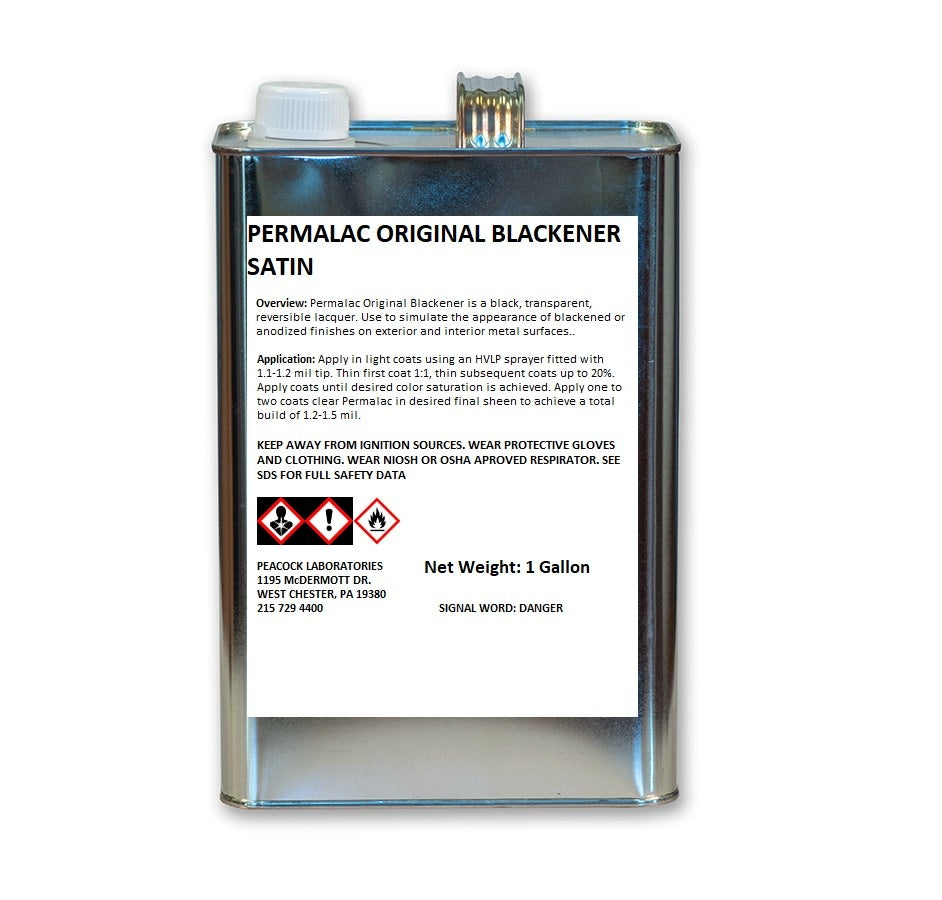Permalac
Blackener Transparent
Blackener Transparent
4 in stock
Couldn't load pickup availability
Permalac Original Black is a fast-drying, easy-to-apply acrylic lacquer coating. It is an opaque tinted formula which lays down similar to a paint. Permalac Original Black is highly resistant to environmental breakdown caused by UV, acid rain, and salt. It has outstanding adhesion to a variety of substrates, including patinated and polished metals, hard woods, and masonry or stone products. Users report excellent results on copper, brass, bronze, steel, aluminum, zinc, and painted wood substrates.
IMPORTANT USAGE INSTRUCTIONS READ ME
Permalac is a fast-drying, easy-to-apply, acrylic lacquer coating. Permalac is highly resistant to
environmental breakdown caused by UV, acid rain, and salt. It has outstanding adhesion to a
variety of substrates, including patinated and polished metals, hard woods, and masonry or stone
products. Users report excellent results on copper, brass, bronze, steel, aluminum, zinc, and painted
wood substrates in both land and marine applications.
The following instructions can be applied to all sheens of the Permalac Original, Permalac EF,
Permalac NT, and Permalac Blackener.
Determine your method of application: This decision should be made based on your own
experience and skill level, as well as the size and nature of the job. If the Permalac must be applied
on location, it might be best to apply with a brush to avoid overspray. Small parts and jewelry
might be best dipped. You might wish to spray a large project for speed and ease of application.
Regardless of your application method, it is important that your substrate is clean and free of
moisture. We recommend that you wipe non-porous substrates with acetone or lacquer thinner to
degrease and assist in wetting.
Spraying Permalac: When spraying Permalac, you may need to thin it first. This can be done with most
commercially available lacquer thinners. Peacock Laboratories also manufactures a complete array of
thinners to suit varying weather conditions and customer preferences. The mix ratio is four parts
Permalac to one part thinner. You may wish to increase this ratio to three parts Permalac to one part
thinner if conditions are particularly hot and dry or if the substrate is particularly porous. For spraying
steel, the mix ratio is one-part Permalac to one part thinner for the first coat, then four parts Permalac
to one part thinner for the remaining coats. Once the Permalac has been reduced, it can be sprayed. Be
sure to follow all the safety guidelines outlined in the SDS sheet(s). This includes using an NAIC-
approved organic solvent respirator, goggles, and using Permalac in a ventilated area. The
recommended spray gun is an HVLP sprayer with a 1.0-1.3 mm tip. Use 25-30 psi and adjust the gun
so the material is fully atomized. You also want to avoid large droplets in your spray. When spraying,
you want to be laying enough coating that the surface appears wet, and the droplets flow together.
Apply 3 coats for interior applications OR 4-6 coats for exterior applications in this manner (wood may
require 4-8 coats), allowing 30-60 minutes between coats.
4
You may wish to add anywhere between 2-5% of our #500 retarding thinner to your lacquer mix
to combat issues such as solvent pop or hazing because of high humidity or temperature in the
surrounding environment. If you see orange peel, allow the Permalac to cure for 1 to 2 hours and
then wet sand with 400 grit paper. Use a cloth to remove the resulting dust and moisture and apply
a final coat of Permalac. When finished, allow 72 hours minimum before packing the item or
putting it to use. Clean your equipment with acetone or lacquer thinner.
Brushing Permalac: Permalac can be brushed on at full concentration. During hot weather, you
may wish to thin the Permalac by 15% with a standard thinner or 5% with a retarding thinner to
help flow out brush marks. Use a good quality solvent-grade brush and do not overwork. Apply 3
coats for interior applications OR 4-6 coats for exterior applications, waiting 30 minutes-1.5 hours
between coats. Allow it to cure for 24 hours minimum (72 hours highly recommended). Clean-up
with acetone.
Dipping Permalac: Use a hook or appropriate jig to dip your part into Permalac. Gently shake off
any excess droplets. Allow to dry one hour and repeat. Allow to cure for 24 hours (72 hours highly
recommended).
Maintaining/Cleaning Permalac: Wash Permalac with soap, water, and a soft sponge or rag. Do
not use abrasive cleaners or scouring pads. Do not use solvents, such as mineral spirits or acetone.
Do not use any cleaners with acidic components or any compounds such as ammonia. Scratches
can be repaired by cleaning the damaged area with soap and water, allowing it to fully dry, then
finally reapplying Permalac. Should you need to remove Permalac, it can be stripped with either
lacquer thinner or acetone.
Reapplying Permalac with time: Permalac usually lasts about 8-10 years on interior applications
and approximately 3-5 years on exterior applications. It should still be reapplied as necessary to
maintain the finish and its protective capabilities. Reapplication window for Permalac is every 3-
5 years or as you see the finish begin to wear down with time. The existing Permalac layer can be
cleaned with soap and water solution, and then coated on top with more layers of Permalac (as
recommended in the first section). Alternatively, you can choose to strip down the Permalac layers
currently existing on your substrate with acetone or lacquer thinner (soaked on a rag and wiped on
for instance) and then reapply as recommended.
Share





- Choosing a selection results in a full page refresh.
- Opens in a new window.

